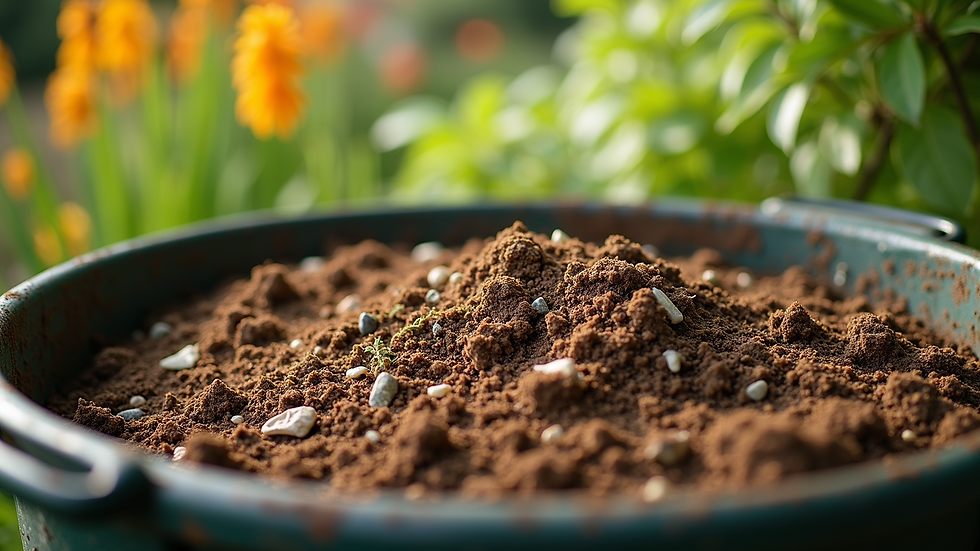Eco-Friendly Gardening: Tips for a Greener Space
- Susan Brown
- Sep 7
- 4 min read
Creating a garden that’s kind to the planet feels like planting a little hope for the future. When I first started my gardening journey, I wanted to make sure every step I took was gentle on the earth. It’s amazing how small changes can bloom into a lush, vibrant space that’s both beautiful and sustainable. Let’s dive into some practical, easy-to-follow sustainable gardening tips that will help you grow a greener garden with joy and care.
Embrace Native Plants for a Thriving Garden
One of the best ways to start your sustainable garden is by choosing native plants. These plants have evolved to thrive in your local climate and soil, which means they need less water, fertilizer, and pest control. Plus, they provide essential habitats for local wildlife like bees, butterflies, and birds.
For example, if you live in a temperate region, native wildflowers and grasses can add color and texture without demanding extra resources. Native shrubs and trees also help improve soil health and prevent erosion. When you plant native, you’re working with nature, not against it.
Tips for choosing native plants:
Visit local nurseries or botanical gardens to see what grows naturally in your area.
Research online or check with local gardening groups for native plant lists.
Mix different types of plants to create a balanced ecosystem.

Water Wisely with Sustainable Gardening Tips
Water is precious, and using it wisely is a cornerstone of sustainable gardening. I’ve learned that watering early in the morning or late in the evening reduces evaporation, so your plants get the most benefit. Installing drip irrigation or soaker hoses can deliver water directly to the roots, cutting down waste.
Collecting rainwater is another fantastic way to stay eco-friendly. A simple rain barrel can capture runoff from your roof, giving you a free and natural water source for your garden. Mulching around plants also helps retain moisture and keeps the soil cool.
Here’s a quick checklist for water-wise gardening:
Water deeply but less frequently to encourage strong roots.
Use mulch to lock in moisture and reduce weeds.
Group plants with similar water needs together.
Consider drought-tolerant plants to reduce watering needs.

Composting: Nature’s Recycling System
Composting is like magic for your garden soil. Instead of tossing kitchen scraps and yard waste into the trash, you can turn them into rich, dark compost that feeds your plants naturally. I started composting with a simple bin in my backyard, and it’s been a game-changer.
Compost improves soil structure, retains moisture, and provides nutrients without synthetic fertilizers. Plus, it reduces landfill waste and greenhouse gas emissions. You can compost vegetable peels, coffee grounds, eggshells, grass clippings, and leaves. Just avoid meat, dairy, and oily foods.
How to start composting:
Choose a compost bin or create a pile in a shady spot.
Alternate green materials (kitchen scraps, fresh grass) with brown materials (dry leaves, cardboard).
Turn the pile every few weeks to aerate it.
Keep it moist but not soggy.
Your garden will thank you with healthier plants and happier soil!

Create Wildlife-Friendly Habitats
A sustainable garden isn’t just about plants; it’s about creating a welcoming home for wildlife. Birds, bees, butterflies, and beneficial insects play vital roles in pollination and pest control. I love spotting ladybugs and hummingbirds visiting my garden—it feels like a little celebration of life.
To invite wildlife, plant a variety of flowering plants that bloom at different times of the year. Include shrubs and trees for shelter and nesting. Avoid pesticides that harm beneficial insects. You can also add bird feeders, bat boxes, or bee hotels to support local species.
Simple ways to support wildlife:
Plant pollinator-friendly flowers like lavender, coneflowers, and sunflowers.
Leave some leaf litter or brush piles for insects and small animals.
Provide a shallow water source like a birdbath.
Use organic gardening methods to keep the environment safe.
By nurturing wildlife, you’re helping your garden flourish naturally.
Reduce, Reuse, and Recycle in Your Garden
Sustainability is all about making the most of what you have. I try to reuse materials whenever possible—old containers become planters, broken pots turn into drainage layers, and scrap wood can be repurposed for garden markers.
Using recycled or sustainably sourced materials for garden beds, paths, and furniture reduces waste and environmental impact. When buying tools or supplies, I look for durable, eco-friendly options that will last.
Here are some ideas to reduce waste in your garden:
Use fallen leaves as mulch or compost material.
Repurpose kitchen jars for seed starters.
Collect and reuse rainwater with barrels or buckets.
Choose organic seeds and plants from local sources.
Every little effort adds up to a greener, cleaner garden space.
Gardening sustainably is a rewarding journey that connects us to the earth in a meaningful way. If you want to explore more eco-friendly gardening tips, there are plenty of resources to inspire your next steps. Remember, your garden is a living canvas—paint it with care, patience, and love, and watch it grow into a vibrant sanctuary for you and the planet.
Happy gardening!





Comments